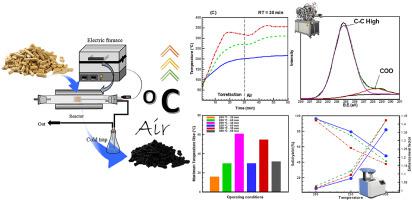Our official English website, www.x-mol.net, welcomes your feedback! (Note: you will need to create a separate account there.)
Impact of post-torrefaction process on biochar formation from wood pellets and self-heating phenomena for production safety
Energy ( IF 9 ) Pub Date : 2020-09-01 , DOI: 10.1016/j.energy.2020.118324 Emmanuel Arriola , Wei-Hsin Chen , Yi-Kai Chih , Mark Daniel De Luna , Pau Loke Show
Energy ( IF 9 ) Pub Date : 2020-09-01 , DOI: 10.1016/j.energy.2020.118324 Emmanuel Arriola , Wei-Hsin Chen , Yi-Kai Chih , Mark Daniel De Luna , Pau Loke Show

|
Abstract The advancement of torrefaction in the industry raises safety issues lately. This work aims to investigate the impact of post-torrefaction upon biochar formation and the self-heating phenomena of torrefied wood pellets. Three operating scenarios are taken into account. Specifically, dried wood pellets are first torrefied in nitrogen at various temperatures (200–300 °C) followed by immediate exposure to N2 or air with/without keeping temperature, namely, the post-torrefaction, to examine the self-heating behavior. Meanwhile, the influences of torrefaction temperature, duration, and self-heating on biochar’s characteristics are analyzed. It is found that self-heating with the highest temperature rise of 61 °C is triggered when the biochars are in an oxidative post-torrefaction process with keeping temperature. Alternatively, oxidative post-torrefaction without keeping temperature can efficiently intensify the pellets’ calorific value up to 42%. The X-ray photoelectron spectroscopy analysis reveals the depletion of the CO functional group. It is concluded that uncontrolled self-heating in large scale production will lead to combustion and make biochar unsafe. Alternatively, if heat accumulation inside the biochar piles can be prevented, the oxidative environment that causes self-heating can open a lot of research opportunities that can help in the advancement of torrefaction technologies for biomass as an alternative source of energy.
中文翻译:

后烘焙工艺对木屑颗粒生物炭形成的影响和自热现象对生产安全的影响
摘要 烘焙行业的进步最近引发了安全问题。这项工作旨在研究烘焙后对生物炭形成的影响以及烘焙木颗粒的自热现象。考虑了三种操作场景。具体来说,干燥的木屑颗粒首先在不同温度(200-300°C)下在氮气中烘烤,然后立即暴露于 N2 或空气中,保持/不保持温度,即后烘烤,以检查自热行为。同时,分析了烘焙温度、时间和自热对生物炭特性的影响。发现当生物炭处于氧化后烘焙过程并保持温度时,会触发自加热,最高温升为 61 °C。或者,不保温的氧化后烘焙可以有效地将颗粒的热值提高到 42%。X 射线光电子能谱分析揭示了 CO 官能团的消耗。结论是,大规模生产中不受控制的自热会导致燃烧并使生物炭不安全。或者,如果可以防止生物炭堆内的热量积聚,导致自热的氧化环境可以开辟大量研究机会,有助于将生物质作为替代能源的烘焙技术的发展。结论是,大规模生产中不受控制的自热会导致燃烧并使生物炭不安全。或者,如果可以防止生物炭堆内的热量积聚,导致自热的氧化环境可以开辟大量研究机会,有助于推动将生物质作为替代能源的烘焙技术的发展。结论是,大规模生产中不受控制的自热会导致燃烧并使生物炭不安全。或者,如果可以防止生物炭堆内的热量积聚,导致自热的氧化环境可以开辟大量研究机会,有助于将生物质作为替代能源的烘焙技术的发展。
更新日期:2020-09-01
中文翻译:

后烘焙工艺对木屑颗粒生物炭形成的影响和自热现象对生产安全的影响
摘要 烘焙行业的进步最近引发了安全问题。这项工作旨在研究烘焙后对生物炭形成的影响以及烘焙木颗粒的自热现象。考虑了三种操作场景。具体来说,干燥的木屑颗粒首先在不同温度(200-300°C)下在氮气中烘烤,然后立即暴露于 N2 或空气中,保持/不保持温度,即后烘烤,以检查自热行为。同时,分析了烘焙温度、时间和自热对生物炭特性的影响。发现当生物炭处于氧化后烘焙过程并保持温度时,会触发自加热,最高温升为 61 °C。或者,不保温的氧化后烘焙可以有效地将颗粒的热值提高到 42%。X 射线光电子能谱分析揭示了 CO 官能团的消耗。结论是,大规模生产中不受控制的自热会导致燃烧并使生物炭不安全。或者,如果可以防止生物炭堆内的热量积聚,导致自热的氧化环境可以开辟大量研究机会,有助于将生物质作为替代能源的烘焙技术的发展。结论是,大规模生产中不受控制的自热会导致燃烧并使生物炭不安全。或者,如果可以防止生物炭堆内的热量积聚,导致自热的氧化环境可以开辟大量研究机会,有助于推动将生物质作为替代能源的烘焙技术的发展。结论是,大规模生产中不受控制的自热会导致燃烧并使生物炭不安全。或者,如果可以防止生物炭堆内的热量积聚,导致自热的氧化环境可以开辟大量研究机会,有助于将生物质作为替代能源的烘焙技术的发展。



























 京公网安备 11010802027423号
京公网安备 11010802027423号